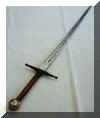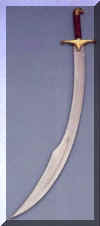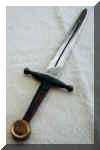Swords and Daggers of the Past
The
History of Metal Sword Production
Long
Swords (one & two handed), Two-handed
Swords, Claymores, Scimitars,
Broad
Swords (one & two handed, Short Swords, Great
Swords, Bastard Swords, Daggers
The development of metal weapons began around 3500-3000BC. These
weapons (mainly swords) were first made of copper and were generally no longer
than a long dagger.
About 2900BC, bronze was discovered which
allowed the first real, strong blades of suitable length to be made.
Then,
around 1500BC, a great technological advancement was made; the smelting of iron.
This allowed swords of great strength and length to be made, however with a
human of that time period standing around 1.7 metres tall (5 feet 6 inches) made
any swords longer than a metre (40 inches) almost totally ineffective to use in
combat.
It was about this time that sheaths (also known as
scabbards) became prevalent due to the fact that swords could be sharpened to an
edge not known with bronze or copper swords. This made sheaths useful in
protecting sharp swords.
Then in the early 3rd century AD long
swords became widespread after the defeat of the Roman Empire - partly because
the swords used by the Roman soldiers were plagued with problems in their design
- especially around the handle.
The popularity of the long sword
was also due to its use on horseback, this sword was an effective weapon for
cutting rather thrusting. From the 3rd century AD to the beginning of the
Charlemagne period, the long sword remained unchanged.
Throughout
the early middle ages improvements were continued to be made, with most
improvements taking place in the region known as France in Europe.
During
the 13th and 14th centuries, sword craftsmanship reached its peak, with grips
being engraved and inlaid; the pommels were large and highly decorated and the
crossguards were often so large that they made the sword look more like a cross
than a weapon.
Then, during the 15th and 16th centuries, armies
began to get bigger and more mobile and because of a lack of people able to use
the longbow, swords began to be issues en-masse to soldiers and what was once
the main part of nobles and knights for many years became common-place and
therefore generally useless.
And finally, up until the beginning
of World War One, swords were still used in combat even though firearms became
widespread.
The long swords were the primary weapon used for combat
throughout the middle ages. They first came into widespread use after the
defeat of the Roman Empire in the 3rd century AD but had existed in various
forms for about a thousand years before then.
During the middle ages, the long sword was mostly used by
nobles and knights as it was a weapon of authority. This changed in the 15th
and 16th centuries when longbow men were in short supply, forcing people to
learn how to use the sword. At this time the sword lost its prestige among the
knights and nobles and became a commonly used weapon in combat.
Of all the weapons from this period of history, the long sword
is the best known of them.

Long Sword
These swords are a very large and heavy weapon usually used to deliver
direct overhead blows. Because of their bulk these swords made it nearly
impossible to hit any but the least nimble of opponents.
The Swiss used the two-handed swords almost exclusively until the end of
the 15th century when the sword was suppressed and Pikes became the weapon of
choice.
Two-handed swords were mostly used in the eastern countries although the Chinese
nor the Mongolian hordes ever adopted this weapon by choice. The best known
swords of this kind were the Japanese Katana (fighting swords).
The Claymore is a Scottish version of the two-handed sword. This sword got
its name from a Gaelic translation of the words 'Great Sword' which is another
name for the 'two-handed swords'.
This sword was in use for a number of centuries but became widespread in
the 15th and 16th centuries.
With the size of the sword it was used mainly to deliver a tremendous
overhead smashing blow. Because of this, these swords were generally only used
in fighting and were not usually decorated.

Scottish Claymore
Scimitars are one of the more unusual types of weapon used in combat.
Although these swords are supposed to have come from the middle east, they
didn't, this weapon came from the European countries.
Even though Scimitars have an unusual blade, they are quite easy to use in
combat and because of their uniform shape they are easy to remove from their
scabbards.
Because of their use in combat, scimitars were plain and did not have much
in the way of decoration.

Scimitar
Broad swords are a straight, wide, single-edged blade with a basket hilt.
These swords are quite often confused with two-handed swords and another type
of sword known as a 'back sword' which is similar to a later sword model known
as the 'sabre'.

Broad Sword
The short sword is a smaller version of the long sword mainly used for
close quarter combat and for thrusting. Whereas a long sword needs a fair
amount of space for swinging, a short sword needs very little, making it an
ideal weapon against small generally unarmoured opponents with either the
small or mediums sized weapons.
The Great sword is another type of two-handed sword. Generally these are
almost identical but are just different in name. The term 'great sword' came
from the large size of the weapon compared to the smaller long swords.

Great Sword
This type of sword is a generally misunderstood and misrepresented weapon
for hundreds of years. With the sword having a long straight blade, long
handle and a rounded pommel, it is not seen as an exotic weapon.

Bastard Sword
The dagger was the earliest type of weapon made. Examples have existed from
before 3500BC when the first swords were made of copper. Daggers were commonly
in use up until 500BC when they fell out of favour and the sword became the
common weapon.
It wasn't until the period of Charlemagne that daggers began to become
widespread again.
Throughout the years the dagger has undergone many changes in shape and
design, but it generally always been shorter than the swords. Other names for
daggers depend on the shape and design of the dagger and the region and time
period that they came from.
Some of the best known daggers have been the 'Dirk' from Scotland around
the 14th century, the Bowie Knife from Kentucky (USA) in 1830, the commando
knife used in WW1 and WW2, the Quillon from the Celtic civilization around
1500BC which resembled a small sword and was mainly worn by knights during the
middle ages, and the Stilletto from Italy around the 16th century.

Dagger
For further information on these and other weapons and
armour described here in these
web pages, see my bibliography page.
Click on the Back icon to return to the Weapons page or
Next to go to the Crushing Weapons page






